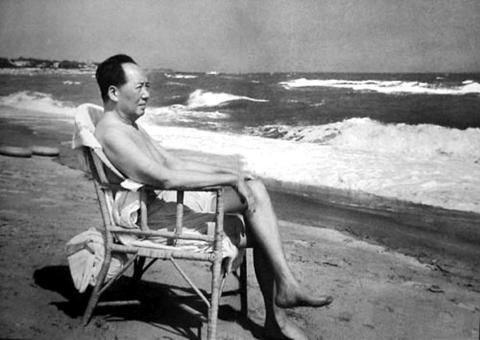Now is a good time to see several exhibitions in Taipei that depict the world through the eye of a camera lens and that tend to be historical and documentary in nature. Heading the list is a must-see show for you history buffs entitled The Era of Mao currently on view at TIVAC until July 6.
These 51 small black-and-white framed photographs by the husband and wife duo Xu Xiaobing (
However, in spite of trying to capture various intimate moments of the chairman who is seen playing with his children or swimming in a lake, the photos tend to make him look iconic. Shot at low angles, he often appears much larger than life.

PHOTO COURTESY OF TIVAC
The first floor of TIVAC's exhibition space contains the heroic portraits of Mao and some documentary photographs of significant events, such as his meeting with the young Dalai Lama and the Panchen Lama in 1954.
The photographer couple, Xu and Hou, were fairly anonymous during their career, while their work gained acclaim. When Xu was 21, he joined the Communist Party and by then had become a seasoned photographer. He recorded the victories of the Eight Route Army.
Hou, 8 years his junior, joined the party when she was 14, worked with Xu making photographs and learning the trade, and when she was 25 years old, became Mao's only private photographer, a position she held for 12 years. Her most famous photograph is titled Ceremony of the Country Establishment, which was shot on Oct. 1, 1949, at Tiananmen Square and which commemorated the historical event that marked a turning point of Mao's political career.
Installed in TIVAC's basement are grainy images of military struggle that took place during the 1940s. Here these fading documents of China's military strikes against Japan seem like movie stills and could be about any battle in any part of the world -- that is if fought by soldiers on horses running through the desert.
TIVAC had to make many negotiations to secure the work here, and it is the first time these images have been shown in Taiwan. Due to the controversial and sensitive political nature of the photographs, the pictures were sealed in archives for decades and are finally being revealed for the first time in years.
As the images are now currently perceived as a part of history that is long in the past, it seemed the right time to hold such an exhibition. And if you are interested in owning a piece of this early 20th-century history, TIVAC is also selling the prints at affordable prices.
For those of you wanting less history and more of an ethnographic flavor, you may want to go to the June 25 opening at the Hung Chong Gallery, where one can see color photographs by Taipei-based British photographer Nick Mayo who recorded the native dress and daily routines of various tribal inhabitants of southwest China.
Elaborate headdresses, ritual jewelry, weavings and people going about their daily routines to obtain food and water are some of the focal points of these brilliantly colored photographs. For a preview of Mayo's photographic work, you can check out the Web site: http://www.pbase.com/mayonick.
Exhibition notes:
What: The Era of Mao: Photography Exhibition
Where: TIVAC (
When: Until July 6
What: Peoples of Southwest China: Photographs by Nick Mayo
Where: Hung Chong Gallery, 396-1 Ren-Ai Road, (
When: June 25 to July 8.

In the March 9 edition of the Taipei Times a piece by Ninon Godefroy ran with the headine “The quiet, gentle rhythm of Taiwan.” It started with the line “Taiwan is a small, humble place. There is no Eiffel Tower, no pyramids — no singular attraction that draws the world’s attention.” I laughed out loud at that. This was out of no disrespect for the author or the piece, which made some interesting analogies and good points about how both Din Tai Fung’s and Taiwan Semiconductor Manufacturing Co’s (TSMC, 台積電) meticulous attention to detail and quality are not quite up to

April 21 to April 27 Hsieh Er’s (謝娥) political fortunes were rising fast after she got out of jail and joined the Chinese Nationalist Party (KMT) in December 1945. Not only did she hold key positions in various committees, she was elected the only woman on the Taipei City Council and headed to Nanjing in 1946 as the sole Taiwanese female representative to the National Constituent Assembly. With the support of first lady Soong May-ling (宋美齡), she started the Taipei Women’s Association and Taiwan Provincial Women’s Association, where she

It is one of the more remarkable facts of Taiwan history that it was never occupied or claimed by any of the numerous kingdoms of southern China — Han or otherwise — that lay just across the water from it. None of their brilliant ministers ever discovered that Taiwan was a “core interest” of the state whose annexation was “inevitable.” As Paul Kua notes in an excellent monograph laying out how the Portuguese gave Taiwan the name “Formosa,” the first Europeans to express an interest in occupying Taiwan were the Spanish. Tonio Andrade in his seminal work, How Taiwan Became Chinese,

Mongolian influencer Anudari Daarya looks effortlessly glamorous and carefree in her social media posts — but the classically trained pianist’s road to acceptance as a transgender artist has been anything but easy. She is one of a growing number of Mongolian LGBTQ youth challenging stereotypes and fighting for acceptance through media representation in the socially conservative country. LGBTQ Mongolians often hide their identities from their employers and colleagues for fear of discrimination, with a survey by the non-profit LGBT Centre Mongolia showing that only 20 percent of people felt comfortable coming out at work. Daarya, 25, said she has faced discrimination since she